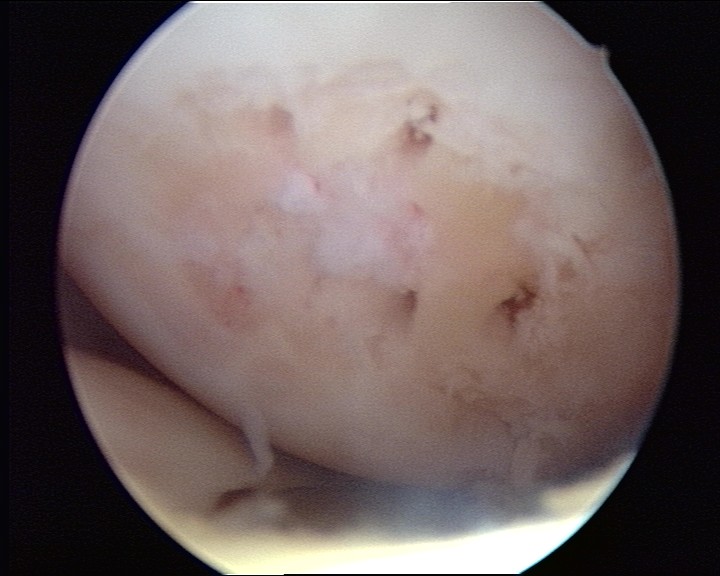Microfracture is a surgical procedure where a tiny 'pick' is used to spike holes through damaged joint cartilage into the bone below with a view to stimulating bleeding and formation of new fibrocartilage.
 Page updated January 2024 by Dr Sheila Strover (Clinical Editor)
Page updated January 2024 by Dr Sheila Strover (Clinical Editor)

The rounded end of the femur, where the joint cartilage has worn away to show the yellowish bone. You can see the pick holes of microfracture piercing through the base plate of the cartilage.

The pick has a long stem and is driven in via the keyhole by the surgeon from the outside of the joint using a small hammer.
How does microfracture work?
The procedure allows migration of marrow cells into the resultant clot, thus facilitating new fibrocartilage formation to cover the defect. The technique was first proposed by Dr Richard (Dick) Steadman, and is one of a group of procedures now referred to as 'marrow stimulation techniques'. The procedure is losing way to nanofracture using a needling device that creates narrower holes, together with augmentation with other regenerative methods such as the injection of stem cells, microfragmented fat or paste grafts.
Pain after microfracture
Rehabilitation after microfracture can be a challenge. The procedure is quite painful and the joint surface has to be protected by non weight bearing until fibrocartilage covers the defect.
Forum discussions
- Trochlear Groove Microfracture
Experienced forum members discuss the first few weeks of rehabilitation after microfracture surgery.
- Hugh's microfracture diary
Talking about reasons for talking rehab slowly after microfracture..
- 16.5 Months Later - I am happy and active
A discussion about progress a year and a half after microfracture.
- I accidentally stepped on my foot 4 weeks after microfractures surgery..
An anxious patient is concerned about weight-bearing after microfracture.
Peer-reviewed papers
-
Quote:
"....compliance with rehabilitation, knee alignment, and the depth of the cartilage rim surrounding the lesion are a few of the factors that can affect the outcomes..."
Citation: Steadman JR, Rodkey WG, Briggs KK. Microfracture: Its History and Experience of the Developing Surgeon. Cartilage. 2010 Apr;1(2):78-86. doi: 10.1177/1947603510365533. PMID: 26069538; PMCID: PMC4297044.
-
Quote:
"The quality of cartilage repair following microfracture is variable and inconsistent...Younger patients have better clinical outcomes....patients with lesions of the femoral condyle have the best clinical improvements....smaller lesions have better clinical improvement..."
Citation: Erggelet C, Vavken P. Microfracture for the treatment of cartilage defects in the knee joint - A golden standard? J Clin Orthop Trauma. 2016 Jul-Sep;7(3):145-52. doi: 10.1016/j.jcot.2016.06.015. Epub 2016 Jun 28. PMID: 27489408; PMCID: PMC4949407.
Also relevant -
 2016 - Surgical cartilage repair for knee osteoarthritis - part of a Primer on Osteoarthritis management options - by Dr Sheila Strover (Clinical Editor)
2016 - Surgical cartilage repair for knee osteoarthritis - part of a Primer on Osteoarthritis management options - by Dr Sheila Strover (Clinical Editor)
 2008 - Course -
2008 - Course -